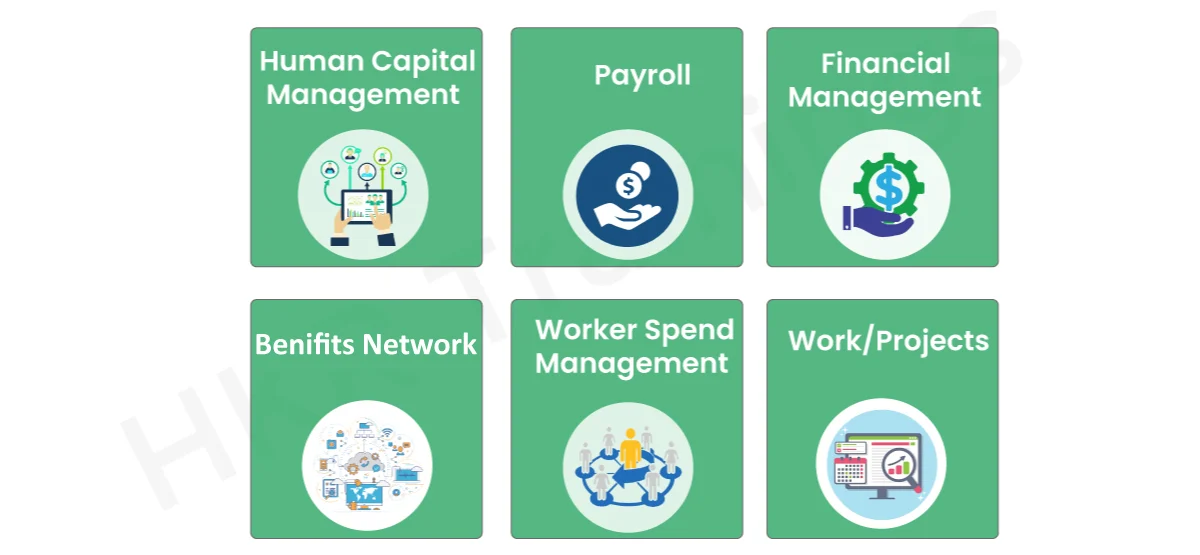How does Workday work - Table of Content
- What is Workday?
- Features and benefits of Workday
- Workday Architecture
- How do business processes work with Workday?
- Conclusion
What is Workday?
Workday represents a cutting-edge, cloud-based software suite engineered to streamline and enhance enterprise resource planning (ERP), human capital management (HCM), and financial management operations across diverse organizational landscapes. This versatile platform is adept at catering to the dynamic needs of organizations, regardless of their size – from small businesses to large corporations. The core of Human Capital Management within Workday encapsulates a broad spectrum of HR functionalities, including but not limited to talent acquisition, workforce development, and optimization of human resources.
A unified software solution becomes paramount in the modern business ecosystem, where distinct functions and operational demands characterize sections. Workday steps into this role, offering a collective environment where teams from various departments can synergize their efforts toward elevating business performance and growth. The software's flexibility allows it to be tailored to specific business needs, making it an ideal choice for entities focused on human resources and other sectors.
Start learning Workday Training from hkrtrainings to make a bright career in the world of workday!
Features and benefits of Workday:
The design ethos of Workday is centered around positioning people at the heart of enterprise operations. This software suite boasts various features, primarily elevating its stature in the modern business. Let's delve into these features and their respective benefits:
1) Human Resource Management:
Workday revolutionizes HRM by streamlining hiring processes and enhancing workforce management. Its self-service capabilities empower managers and employees alike, fostering efficient operational workflows. Key functionalities also include complete absence and compensation management.
2) Talent Management:
This aspect of Workday surrounds a suite of tools to refine employee management, development, and reward systems. It covers critical areas like performance and goal management, talent onboarding, career building, succession planning, and more, offering a holistic approach to talent management.
3) Recruiting:
Workday excels in managing end-to-end hiring processes. It provides tools for seamless coordination among hiring teams, backed by real-time data, thus enabling strategic recruitment planning and execution.
4) Benefits Administration:
Workday simplifies the management of diverse benefit plans, integrating seamlessly with various providers to streamline employee data handling.
5) Time Tracking:
The software offers versatile time-tracking options across devices, including integration capabilities with physical clock systems, catering to varied business needs.
6) Payroll Management:
Workday's payroll module is robust, providing comprehensive insights into employee earnings and deductions while facilitating seamless integrations with third-party payroll services.
7) Big Data Analytics:
By merging non-Workday data sources with its own, Workday offers expansive analytics capabilities, addresses key HR and financial concerns, and aids in strategic decision-making.
Take your career to next level in workday with HKR. Enroll now to get Workday Training In Hyderabad Demo !

Workday Training
- Master Your Craft
- Lifetime LMS & Faculty Access
- 24/7 online expert support
- Real-world & Project Based Learning
Workday Architecture:
Workday architecture is a testament to its advanced object-oriented design, ensuring the continuous evolution of technology without disruptions. The main components of this architecture include:

1) UI Server:
Known for its adaptability, the UI Server supports various formats and devices, offering automatic UI generation and export options.
2) Object Management Server:
Serving as the core processing engine, it handles requests from both UI and integration servers.
3) Integration Server:
Specializing in web services, it is adept at handling SOAP-based integrations, ensuring reliable data translation and delivery.
4) Persistent Store:
Responsible for data storage, backups, and replications, this component is critical for data integrity and security.
5) Data Source and Business Object Handling:
Workday's handling of data sources and business objects like workers, positions, etc., is secure and efficient, representing data in an easily manageable form.
Get ahead in your career with our Workday Tutorial !

Subscribe to our YouTube channel to get new updates..!
How do business processes work with Workday?
Workday is at the heart of business process management, streamlining various HR-related tasks such as hiring, compensation proposals, and terminations. It emphasizes the need to visualize process flows before system implementation. The flexibility of Workday allows for tailored business process construction, accommodating different scenarios like e-commerce operations.
Workday's business process framework includes initiation, action, approval, approval chain, service, consolidated approval, integration, report, batch, to-do, and checklist steps, each contributing to a comprehensive business process management system.
Top 30 frequently asked workday interview questions for freshers & experienced professionals
Conclusion:
The demand for platforms like Workday, which deliver excellence and aid enterprises in achieving their goals, is rising. Workday's suite enhances business processes and operational flows effectively. Gaining hands-on experience and understanding of Workday opens up global job offers. It is also suggested for those seeking to advance their IT and business management careers. Learning and developing skills in Workday can pave the way for a professional journey marked by expertise and growth in the IT field.
Other Related Articles:
About Author
As a Senior Writer for HKR Trainings, Sai Manikanth has a great understanding of today’s data-driven environment, which includes key aspects such as Business Intelligence and data management. He manages the task of creating great content in the areas of Digital Marketing, Content Management, Project Management & Methodologies, Product Lifecycle Management Tools. Connect with him on LinkedIn and Twitter.
Upcoming Workday Training Online classes
| Batch starts on 19th Dec 2025 |
|
||
| Batch starts on 23rd Dec 2025 |
|
||
| Batch starts on 27th Dec 2025 |
|

